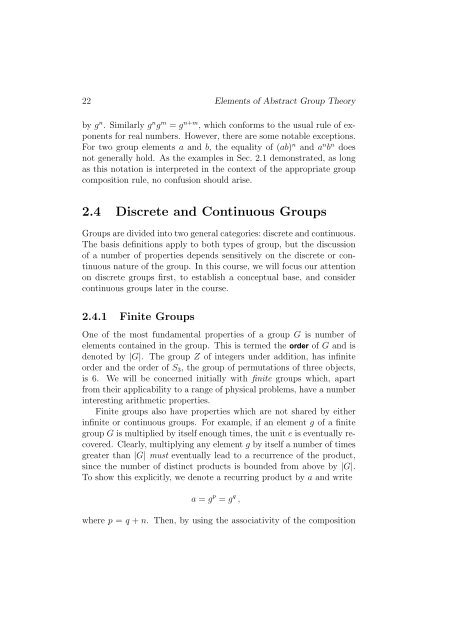Chapter 2 Elements of Abstract Group Theory
Chapter 2 Elements of Abstract Group Theory
Chapter 2 Elements of Abstract Group Theory
You also want an ePaper? Increase the reach of your titles
YUMPU automatically turns print PDFs into web optimized ePapers that Google loves.
22 <strong>Elements</strong> <strong>of</strong> <strong>Abstract</strong> <strong>Group</strong> <strong>Theory</strong><br />
by g n . Similarly g n g m = g n+m , which conforms to the usual rule <strong>of</strong> exponents<br />
for real numbers. However, there are some notable exceptions.<br />
For two group elements a and b, the equality <strong>of</strong> (ab) n and a n b n does<br />
not generally hold. As the examples in Sec. 2.1 demonstrated, as long<br />
as this notation is interpreted in the context <strong>of</strong> the appropriate group<br />
composition rule, no confusion should arise.<br />
2.4 Discrete and Continuous <strong>Group</strong>s<br />
<strong>Group</strong>s are divided into two general categories: discrete and continuous.<br />
The basis definitions apply to both types <strong>of</strong> group, but the discussion<br />
<strong>of</strong> a number <strong>of</strong> properties depends sensitively on the discrete or continuous<br />
nature <strong>of</strong> the group. In this course, we will focus our attention<br />
on discrete groups first, to establish a conceptual base, and consider<br />
continuous groups later in the course.<br />
2.4.1 Finite <strong>Group</strong>s<br />
One <strong>of</strong> the most fundamental properties <strong>of</strong> a group G is number <strong>of</strong><br />
elements contained in the group. This is termed the order <strong>of</strong> G and is<br />
denoted by |G|. The group Z <strong>of</strong> integers under addition, has infinite<br />
order and the order <strong>of</strong> S3, the group <strong>of</strong> permutations <strong>of</strong> three objects,<br />
is 6. We will be concerned initially with finite groups which, apart<br />
from their applicability to a range <strong>of</strong> physical problems, have a number<br />
interesting arithmetic properties.<br />
Finite groups also have properties which are not shared by either<br />
infinite or continuous groups. For example, if an element g <strong>of</strong> a finite<br />
group G is multiplied by itself enough times, the unit e is eventually recovered.<br />
Clearly, multiplying any element g by itself a number <strong>of</strong> times<br />
greater than |G| must eventually lead to a recurrence <strong>of</strong> the product,<br />
since the number <strong>of</strong> distinct products is bounded from above by |G|.<br />
To show this explicitly, we denote a recurring product by a and write<br />
a = g p = g q ,<br />
where p = q + n. Then, by using the associativity <strong>of</strong> the composition













